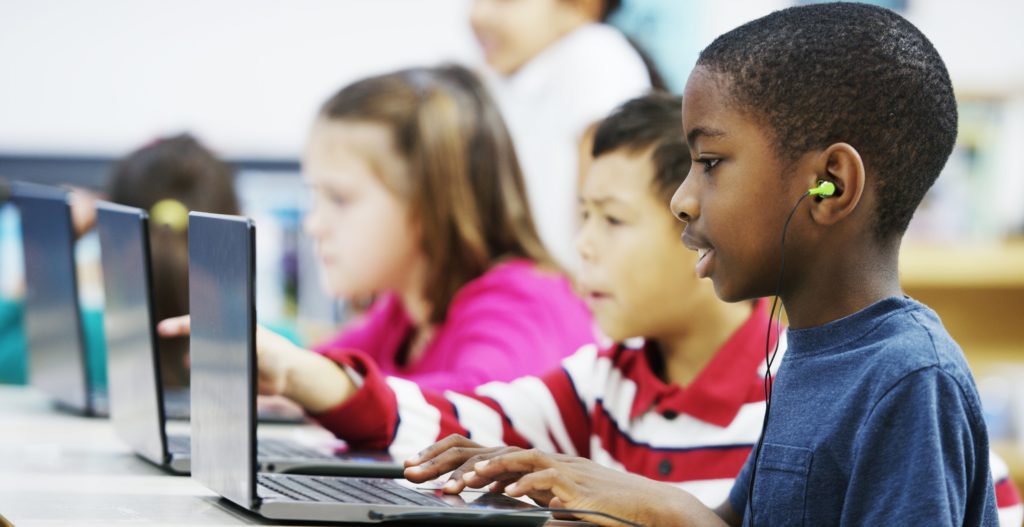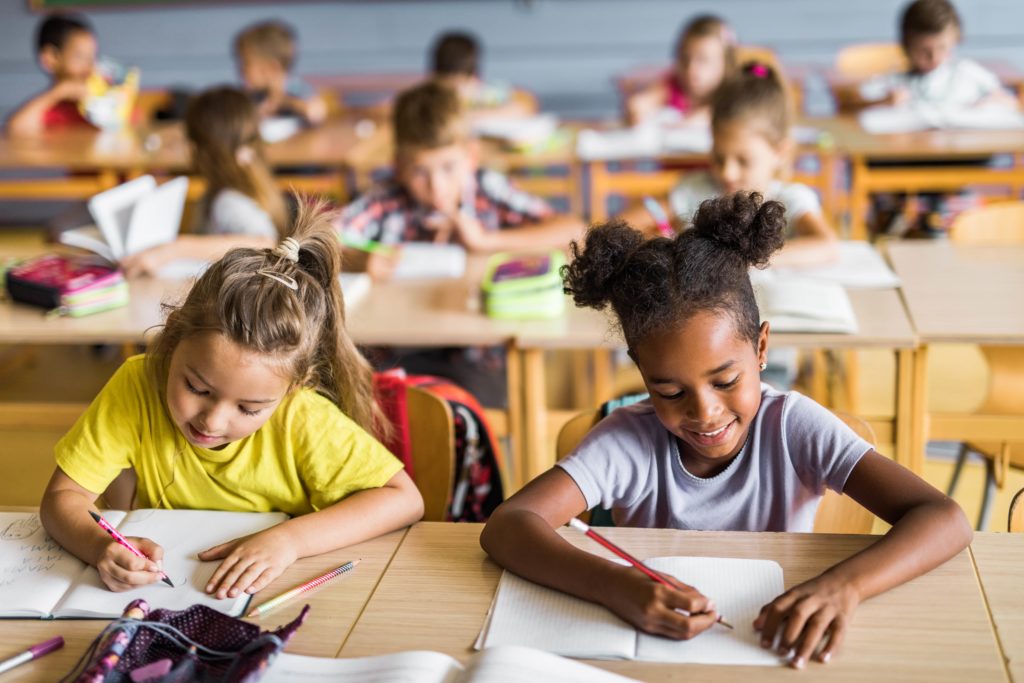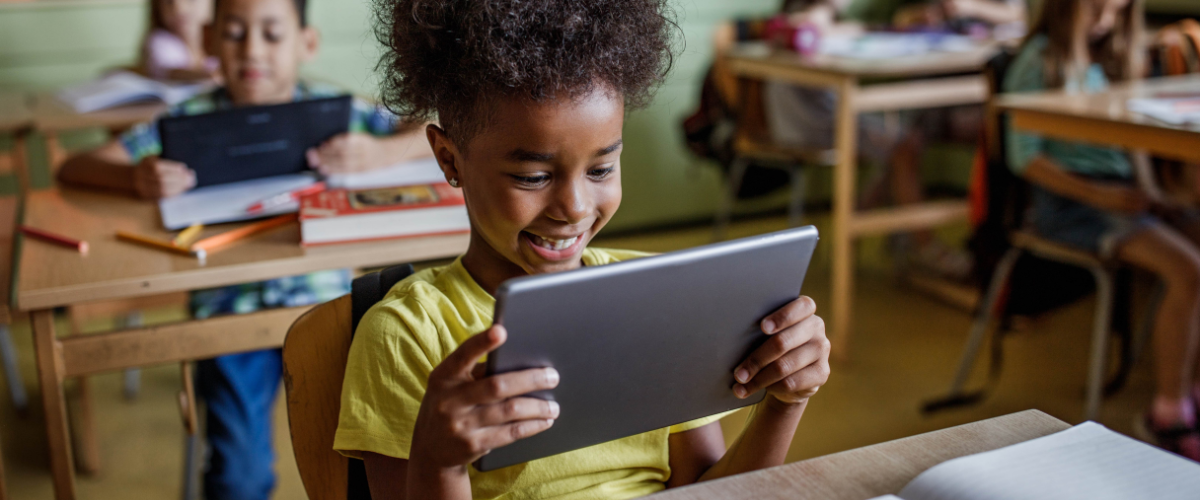Beyond Screens: The Benefits of Paper-Based Learning for Elementary Students
In today’s digital age, technology integration in education helps prepare students for a world of screens. But this cannot be done at the expense of children’s literacy. When students need to read for understanding, comprehension, or retention, research shows that they perform better with print materials rather than a screen.
Too much classroom screen time can cause increased behavior problems, decreased reading comprehension, and attention problems. Research shows that paper learning better engages students, improves material retention and comprehension, and helps them move to a ready-to-learn mindset.
Engagement and Focus
According to the American Academy of Child and Adolescent Psychiatry and the American Academy of Pediatrics, children ages 8-12 spend three times more on screens than is recommended daily. Prolonged screen time can cause eye strain and screen fatigue, leading to vision problems, decreased academic performance, and increased emotional, social, and attention problems.
Excessive screen time is also linked to a decreased interest in reading among elementary school students. At a time when 40% of elementary school students cannot read at a basic level, setting students up for literacy is crucial. Studies Weekly’s print publications equip teachers with materials that support literacy, focus, and engagement away from screens.
“The collective research shows that digital media have common features and user practices that can constrain learning. These include diminished concentration, an entertainment mindset, a propensity to multitask, lack of a fixed physical reference point, reduced use of annotation, and less frequent reviewing of what has been read, heard, or viewed,” said linguistics professor Naomi S. Baron, in How We Read Now.
Because young students are prone to associate technology with entertainment, they are far less likely to give digital learning materials the attention and focus they would devote to their print counterparts. They will likely multitask, skim text, and refrain from engaging with the material.
When students can learn with their own print materials, however, they focus better on what they are doing. Print-based learning is not as linked with entertainment, contains far fewer distractions, and allows students to physically engage with the material through annotation, writing, and drawing – helping students stay on task.
“This type of instruction is so timely and needed today. Many teachers I visit with say there is so much screen fatigue right now. There has been a significant lack of motivation and engagement among students, and behavior issues are at an all-time high,” said Debbie Bagley, veteran educator and Studies Weekly Teacher Advocate. “Many teachers have shared that the only way they have been able to reach their students is to go back to ‘old school,’ by this, I mean getting kids out from behind digital devices and doing more hands-on, interactive learning.”

Students Learn More
Baron’s research also shows that students perform better with print materials.
Students’ understanding, comprehension, and retention were higher when reading print than when reading the same text on a screen or even listening to or viewing the material. Students who read the material in print were also more successful at identifying main ideas, recalling specific details, correctly remembering sequencing, and completing abstract tasks like drawing inferences. Additionally, students of all ages who had read the material in print scored higher on assessments than their peers who had used digital learning.
Researchers point to the “shallowing hypothesis” to attribute some differences in reading comprehension between printed and digital text. According to this theory, the brain naturally takes a casual approach to digital texts and devotes less mental work to reading and understanding them thoroughly. Our brains give more weight to words on a printed page.
The physical properties of paper also account in part for its superior effect on learning. The visual geography of paper has memory-linking effects that help students connect what they have read with where they saw it on a page or how far into a book it was.
Using paper in the classroom also aids learning because students can write on, draw on, and annotate their materials. Research done by experts in memory suggests that drawing, in particular, can strongly affect recollection, and is an effective learning tool.

Learning Ownership
When students have a print copy to work with and make their own, it helps them feel like they are in charge of their own learning. This increases their self-confidence and their investment in the classroom.
Studies Weekly’s print publications are a personal and consumable resource for engaging students. Students can make the print publications their own by highlighting weekly vocabulary words, underlining sight words, writing notes next in the margins, or circling things about which they want to share or ask.
In fact, teachers can set students up for confidence, inquiry, and purposeful learning by allowing students to engage with and draw on their publications before reading the text together. Giving students this trust creates a partnership of learning and growth between students and the teacher.
Creating Connections
Because Studies Weekly’s print publications are consumable, students can create artifacts to demonstrate their learning by cutting the primary sources and other information out of their publications. When students make artifacts, they own their learning, articulate their thinking, and tap into creativity and organizational thinking skills.
Artifacts also help students understand what they are working on and encourage them to connect old and new knowledge. As students physically create artifacts, they visibly represent their thinking, understanding, and skills.
Students can take their artifacts home, share what they learned with their families, and teach younger siblings. Explaining what they know increases their confidence and solidifies their knowledge. Making artifacts at the end of every unit can help a student visualize the progression of their learning and connect the dots between lessons to see the bigger picture.
Print and Online Learning Can Work Together
In the 21st century, digital literacy is essential in the classroom, but educators must balance screen and print use. Both have unique benefits, and when used wisely, can vastly improve student learning and achievement.
Bagley encourages teachers to use Studies Weekly print publications with the Studies Weekly Online learning platform.
“Using both our print and online together gives the greatest benefits by far,” Bagley said. “I honestly cannot imagine teaching social studies without providing each student with a copy of their student publication.”
When planning your lessons for the year, consider the benefits of giving your students consumable printables they can make their own. Research shows that your students will learn, retain, and understand what they read better, and be more engaged, active leaders of their learning.
References
American Optometric Association. (2021). Children’s Vision & Screen Time. Vimeo.
Annisette, L. E., & Lafreniere, K. D. (2017). Social media, texting, and personality: A test of the shallowing hypothesis. Personality and Individual Differences, 115, 154–158.
Backes, B., & Cowan, J. (2019). Is the pen mightier than the keyboard? The effect of online testing on measured student achievement. Economics of Education Review, 68, 89–103.
Baron, N. S. (2016). Words onscreen: The Fate of Reading in a Digital World. Oxford University Press.
Baron, N. S. (2021, May 9). Why do we remember more by reading in print vs. on a screen? Big Think.
Baron, N. S. (2022). How We Read Now: Strategic choices for Print, Screen, and Audio. Oxford University Press.
Christensen, J. (2021, May 28). Children and too much screen time: How much is too much? Mayo Clinic Health System.
Delgado, P., Vargas, C., Ackerman, R., & Salmerón, L. (2018). Don’t throw away your printed books: A meta-analysis on the effects of reading media on reading comprehension. Educational Research Review, 25, 23–38.
Fernandes, M. A., Wammes, J. D., & Meade, M. E. (2018). The Surprisingly Powerful Influence of Drawing on Memory. Current Directions in Psychological Science, 27 (5).
Horton, J. (2019, September 27). What Does Seven+ Hours of Screen Time Do to Students’ Vision? We Are Teachers.
Kaufman, G., & Flanagan, M. (2016). High-Low Split: Divergent Cognitive Construal Levels Triggered by Digital and Non-digital Platforms. Proceedings of the 2016 CHI Conference on Human Factors in Computing Systems, 2773–2777. Essay, Association for Computing Machinery.
Malik, A. (2021, December 21). How Too Much Screen Time Affects Kids’ Eyes: Tips to Prevent Eye Strain. Children’s Hospital of Philadelphia.
Mangen, A., Olivier, G., & Velay, J.-L. (2019). Comparing Comprehension of a Long Text Read in Print Book and on Kindle: Where in the Text and When in the Story? Frontiers in Psychology, 10.
Mangen, A., Walgermo, B. R., & Brønnick, K. (2013). Reading linear texts on paper versus computer screen: Effects on reading comprehension. International Journal of Educational Research, 58, 61–68.
National Literacy Institute. (2022). Literacy statistics.
Salmerón, L., Sampietro, A., & Delgado, P. (2020). Using Internet videos to learn about controversies: Evaluation and integration of multiple and multimodal documents by primary school students. Computers & Education, 148.
Screen Time and Children. American Academy of Child and Adolescent Psychiatry. (2022, February).
Singer, L. M., & Alexander, P. A. (2017). Reading Across Mediums: Effects of Reading Digital and Print Texts on Comprehension and Calibration. The Journal of Experimental Education, 85 (1), 155–172.
Terada, Y. (2019, August 22). The Science of Drawing and Memory. The Science of Drawing and Memory.
